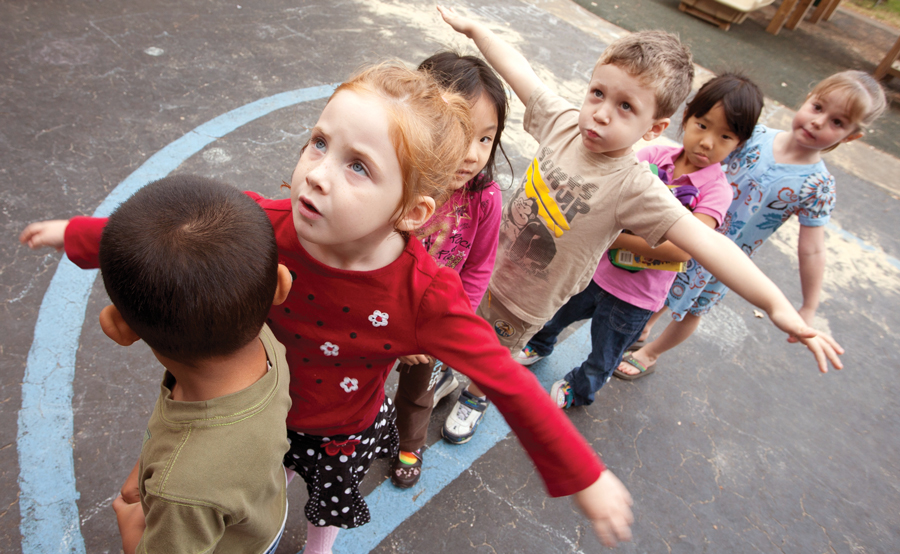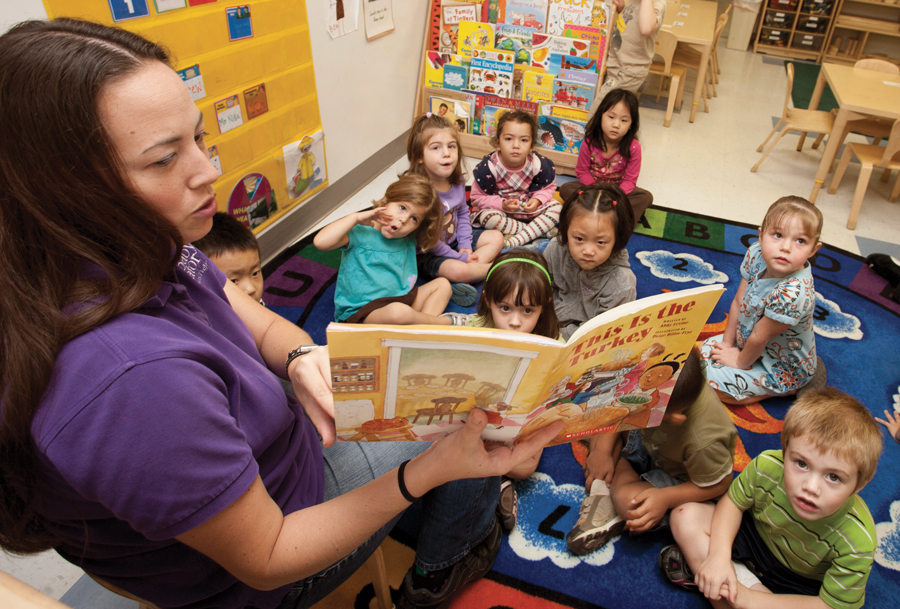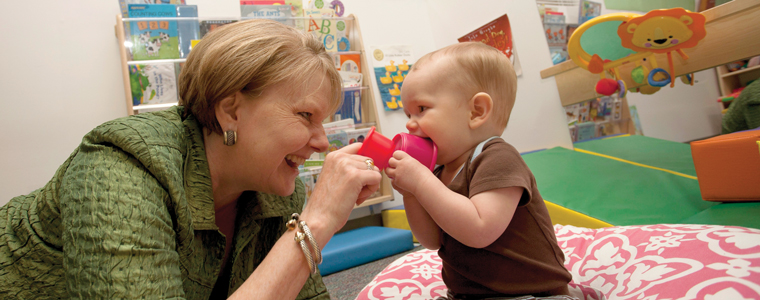Sandra Dodgens was taking a break from being a foster parent after the heartbreak of losing a child with cerebral palsy.
Then a social worker called her about a pair of twins in critical need. The previous foster parent had them for 30 hours and gave up. Dodgens decided to help.
The social worker told her the boys had severe developmental delays with possible autism and dyslexia, and one had obsessive-compulsive disorder. They were 3 years old, but didn’t communicate except for twin-speak. They were not potty trained, but they were agile: She caught them swinging from a chandelier.
Dodgens knew she would need help for the challenge ahead, and one of the people she turned to was Patricia Snyder, an early intervention provider then and now a noted University of Florida early childhood studies researcher.
“These babies had been kept in a vacuum, they were non-verbal and likely headed to special education classes,” Dodgens says. “But I knew Pat, and I knew she was on the cutting edge of work with parental involvement, and she had strategies we could use.”
Dodgens set about labeling the boys’ environment — chair, table, bed — and teaching them to speak and how to behave. Dodgens noticed small changes immediately, and documented the boys’ progress week by week. She grew attached, and
by the time they were 9, she had adopted them.
Today, she is the proud mom of two college students, both thriving.
“A lot of people don’t know that you actually have to engage and talk regularly to young children,” Dodgens says. “If we really want to make a difference in children’s lives, that early investment is the key.”
Snyder says many parents believe a baby cannot interact before learning to talk, and many assume learning begins when a child enters preschool or kindergarten.
“In fact, learning begins at birth, or even before,” Snyder says. “By pre-kindergarten, it’s three years too late if the child, as an infant or toddler, has not had responsive early interactions and learning experiences. Pre-kindergarten is very important, but for children who are most vulnerable, one year of pre-K is not enough to close a gap that can start very early.”
Study after study has shown that 90 percent of brain development occurs in the first five years of life. From birth to age 5, children’s interactions and experiences with their environment build a foundation of brain architecture that influences the remainder of a child’s life, Snyder says.
“Learning doesn’t just happen when you’re reading a book, it happens in everyday life experiences. Learning happens during mealtime, on a walk, in the grocery store, or on the playground. It is critically important to help families understand the contextualized nature of early learning and how responsive, serve-and-return interactions with children in everyday contexts support their development and learning,” Snyder says.
Snyder describes a recent incident she observed that illustrated the importance of early interactions.

While waiting for a flight at the airport, she noticed a young mom traveling with a baby about 4 months old in a stroller. The baby was extremely stressed and crying, obviously hungry, and the mom was talking on her cellphone, not attending to the baby’s cues or signals.
As the baby’s stress level and crying escalated, the mom pulled a bottle from the diaper bag and propped it in her baby’s mouth, then went back to her cellphone. The baby was too young to hold the bottle, so it kept falling out. Each time the bottle fell out of the baby’s mouth, the baby would cry and the mother would reposition the bottle while she talked on the phone.
“I watched this happen three or four times in the span of 10 minutes and never once did the mom leave the cellphone and attend to and comfort her infant or interact with him,” Snyder says. “As I watched this unfold, I realized that even with all of our research and knowledge, we still have such a long way to go to spread the word about the importance of children’s early experiences.”
Reflecting on her work with families, Snyder considered this mother’s capacity as a caregiver and wondered where there might be a strength on which to build. She found an answer when another woman traveling with a small dog sat behind the young mom. Turning away from her cellphone for the first time, the mom began interacting with the dog in a compassionate manner.
“I really do not think the young mother understood the importance of interacting with her baby although she had the capacity to do so,” Snyder says. “For me, this was a concrete and powerful example of a mother who would benefit greatly from the kind of work we do, because we would help her understand the importance of having those same kinds of responsive and nurturing interactions early and often with her child.”
Missed learning opportunities during the very early years, Snyder says, impact K-12 success. One-third of children entering school are unprepared to benefit from the curriculum, and more than half of children cannot read at grade level by fourth grade.
In his book, Disrupting Class, Harvard Professor Clayton Christensen estimates “98 percent of education spending occurs after the basic intellectual capacities of children have been mostly determined.” Pre-kindergarten, with an average national cost of $4,000 per child, starts to look like a bargain next to a Justice Policy Institute estimate that incarcerating juveniles costs more than $148,000 a year per offender. Imagine using some of those resources much earlier, Snyder says.
National Model
David Lawrence, a UF alumnus who retired as publisher of The Miami Herald to spearhead early childhood education initiatives, helped recruit Snyder to UF in 2007 as the David Lawrence Jr. Endowed Chair in Early Childhood Studies. Snyder was happy in her position at Vanderbilt University, but Lawrence’s vision intrigued her.
“UF’s vision, not only for the Lawrence endowment, but also for what early childhood studies could become and how UF had aspirations of becoming a national model was very attractive to me,” Snyder says.
Lawrence says Snyder is “a truly great human being,” as well as the scientist he was looking for to share science-based methods to use in his work on behalf of children.
“I came to understand fully that if you could ever get the early years right, you’d probably have children and then adults with momentum all their lives,” says Lawrence.
By 2010 Snyder had transformed the bustling research and education nexus focused on early childhood studies into an official university center. Snyder’s work got a boost in 2011 when Anita Zucker, a UF College of Education alumna and businesswoman who taught elementary school for 11 years, donated $1 million to endow a professorship in Early Childhood Studies.
“Education really is the key to unlocking doors for later learning and success in life,” says Zucker.
In 2014, the center gained four faculty as part of the UF Preeminence initiative to be recognized as a top 10 public research university. In November 2014, Zucker gave another $5 million, the state matched the gift, and the center was renamed the Anita Zucker Center for Excellence in Early Childhood Studies.
Snyder says she wanted it to be “more than a center in name only,” and the robust research portfolio is evidence that she has reached that goal. To date, the center has attracted almost $16 million in federal research funding. The future of the center also mattered to her.
“Now the center has an endowed chair and an endowed professor. I’m pleased about that milestone, because it ensures there will be Lawrence and Zucker professors working side-by-side in perpetuity who will focus on early childhood studies,” Snyder says. “It was important for us to have an ongoing presence in this interdisciplinary area of study at UF.”
The research also is energized by collaborations across the country and across campus. Snyder regularly collaborates with colleagues in Tennessee, Florida, Illinois and Virginia on national studies. She and other researchers at the center also draw on the expertise of faculty in UF’s colleges of medicine, nursing, and public health and health professions. Snyder and co-director Maureen Conroy are affiliate faculty members with UF’s Institute for Child Health Policy and Snyder holds an affiliate appointment in pediatrics.

Another key collaboration is with UF’s on-campus Baby Gator Child Development and Research Centers, which serve children from 6 weeks to 5 years old. Baby Gator is one of the “living laboratories” for the center’s research. Snyder and her colleagues look forward to a future collaboration between the center and Baby Gator to create an Early Childhood Collaborative facility, envisioned as an “early learning collaboratory campus,” where interdisciplinary groups of students, researchers and practitioners test early learning curricula and interventions.
Its interdisciplinary nature is one of the keys to the center’s work. Children don’t exist in a vacuum, and it takes an interdisciplinary approach to serve the needs of the whole child and family in the context of their communities.
“We want to be a national model for connecting research, policy and practice,” Snyder says. “We want our research, training, and outreach activities to help ensure that each and every child has a chance to succeed, just like Sandra’s boys. Every risk profile would suggest that her boys were on potentially adverse learning trajectories when they came into her life. Her story shows the power of evidence-based approaches to early learning.”
Long-Term Payoffs
Snyder says there is a compelling need for evidence-based approaches that optimize development and learning in the early years, and she has several studies in progress that focus on how children of all abilities and their caregivers and early learning practitioners acquire skills.
“It can be very challenging to conduct applied research in this area, because many people think that early learning is just common sense — that you just need to be nice to young children and all will be well,” Snyder says. “If only it were that simple.”
There are gaps in the existing research that the center is addressing. For example, the center is examining instructional models that support the development and learning of preschoolers with or at risk for disabilities in inclusive classrooms, and caregiver-implemented approaches for infants and toddlers with or at risk for disabilities. So one of Snyder’s research projects focuses on designing, developing and validating interventions teachers and caregivers of these children can use. Once the embedded instruction practices are in place, they will be evaluated to determine whether they lead to improved child outcomes.
The laboratories extend beyond classrooms and community settings. Families often invite researchers into their homes to teach techniques like shared reading or how to turn mealtimes and other social exchanges into learning opportunities. In under-resourced communities, particularly, these techniques help close the gap for children who reach formal educational settings with a smaller vocabulary or fewer quality early learning experiences than their more advantaged peers.
“We take what we know from the science of early childhood development and learning and translate that knowledge into culturally responsive and effective interventions for children and families,” Snyder says.
Children and families who receive interventions and families who do not are carefully tracked over time to determine which strategies work and which do not.
“If we know what quality early learning experiences matter, then another question is how do we support families and early education providers to learn about and use quality practices that are linked to positive child learning outcomes,” Snyder says.
“Thinking back to the baby in the airport; if we were to implement an intervention that built on the mom’s strengths and supported her to be more responsive to his cues, more interactive with him on a regular basis, we would expect better outcomes for him and for his mother — both in the short term and in the long run — just like those outcomes Sandra reported for her and for her boys.”
The center also has become a favored destination for postdoctoral researchers. The U.S. Department
of Education recently funded four postdoctoral fellows who are honing their research skills by working
alongside UF professors in early childhood studies.
It’s not unusual, Snyder says, for a junior researcher to come by her office and say, “You have to come see this video, you have to see the way this mom is interacting with this child. It’s unbelievable. She’s reporting all these changes in her self-confidence about parenting her child.”
Even in the midst of several long-term studies, with the data still out, Snyder often receives anecdotal feedback from former students and families. And when she hears from families with whom she worked
early in her career, she sees research in action.
“It’s really very gratifying, when you see what the long-term payoffs are,” Snyder says. “Even though they’re not findings, published in the journals, you hear about them by email or occasional phone calls or holiday cards. It is rewarding to know that parents of a child, who is now an adult, recognized the power of what early intervention did, not only for themselves, but also for their children.”
Source:
- Patricia Snyder, Professor of Early Childhood Studies
Related Website:
This article was originally featured in the Summer 2015 issue of Explore Magazine.

